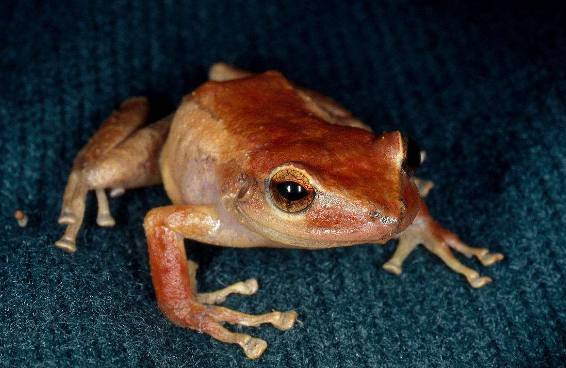(单词翻译:单击)
听力文本
This is Scientific American — 60-Second Science. I'm Jason G. Goldman.
Got a minute?
Coquí frogs. They're named for the sound they make. (Sound) And though just an inch long, a coqui can produce a 90 decibel call—about the volume of a motorcycle 25 feet away.
The animals and their nocturnal chirps are beloved in their native Puerto Rico. But not in Hawaii, where they became invasive in the late 1980s.
The frogs have become a nuisance in part because they cause people to lose sleep, which has actually driven down property values. But some of Hawaii's endangered insect species could face extinction due to the hungry invaders. Biologists also feared that the frogs could impact Hawaii's insect population to such an extent that native birds that also eat insects could go hungry.
A group of researchers has now put that concern to the test by looking at thirty sites on the big island—half that were infested with coquís, and half that were still coquí-free.
"And we didn't see any response in the native birds. They seem to be doing fine with the coquís. At least their abundances were similar in places where there were coquís, and not coquís."
University of Utah ecologist Karen Beard.
"But it was the non-native birds where we really saw the response. And we didn't see it in a negative way."
Three types of non-native birds were actually more abundant in areas with more frogs.
"And we were like, huh. That's kind of interesting."
The researchers think they can explain this in two parts: coquís forage in leaf litter while Hawaii's native insect-eating birds forage in the canopy and understory, so they may be going after different types of prey. Meanwhile, the non-native birds may be getting a boost by eating the frogs themselves. After all, a fingernail sized baby coquí frog is about the same size as a typical rainforest insect. The study is in the journal The Condor.
Despite these findings, coquí frogs could still harm Hawaii's native birds—indirectly.
"If there's a lot more non-native birds, there's a lot more non-native bird nests. That could do something like increase rat and mongoose populations, which are known to be nest predators of native birds."
Hawaii has stopped attempting to eradicate the big island of the invasive hoppers, where some spots may have 10 million coquis per square kilometer. Instead, the focus is on keeping them from expanding even further into the rainforest. To protect local species—and allow them to get some sleep.
Thanks for listening for Scientific American — 60-Second Science. I'm Jason G. Goldman.
参考译文
这里是科学美国人——60秒科学。我是杰森·古德曼。
有一分钟时间吗?
考齐蛙,因叫声而得名。(声音)虽然体长只有1英寸,但是考齐蛙的叫声可以达到90分贝,这相当于25英尺外的摩托车发出的音量。
考齐蛙和它们的夜鸣在波多黎各本地非常受欢迎。但是在夏威夷却并不受欢迎,考齐蛙在夏威夷被视为上世纪80年代后期的入侵物种。
这种青蛙令人讨厌的部分原因是,它们的叫声会使人失眠,继而使当地的房地产价值降低。而且,这些饥饿的入侵者还会使夏威夷的一些濒危昆虫面临灭绝的危险。生物学家还担心考齐蛙会影响夏威夷的昆虫数量,以致同样以昆虫为食的本土鸟类会挨饿。
现在,一组研究人员对这种担心进行了测试,他们观察了夏威夷大岛上的30个地点,其中一半地点被考齐蛙入侵,另一半地点则没有考齐蛙。
“我们没有看到本土鸟类有任何反应。它们似乎可以和考齐蛙友好相处。至少和没有考齐蛙的地点相比,鸟类的数量没有多少区别。”
犹他大学的生态学家凯伦·比尔德说到。
“但是,我们却在非本土鸟类身上看到了反应。我们看到的并不是消极反应。”
实际上在考齐蛙数量更多的地区,三种非本土鸟类的数量也更丰富。
“我们的想法是,哈哈,这有点儿意思。”
研究人员认为可以从两方面来解释这种情况:当考齐蛙在落叶层觅食,而以昆虫为食的夏威夷本土鸟类在树冠层和林下叶层觅食时,它们可能在追逐不同种类的猎物。与此同时,非本土鸟类可能因吃考齐蛙而增加数量。毕竟,指甲大小的考齐蛙幼崽和典型雨林昆虫的大小相似。这项研究结果发表在《神鹰》期刊上。
虽然有了这些研究结果,但是考齐蛙依然会对夏威夷本土鸟类造成间接伤害。
“如果非本土鸟类的数量增多,那非本土鸟类的巢穴也会增加。这可能会增加老鼠和猫鼬的数量,众所周知,这两种动物是本土鸟类的巢穴掠食者。”
夏威夷已经停止试图消灭夏威夷大岛的入侵跳跃者(指考齐蛙),岛上有些地方每平方公里可能有1000万只考齐蛙。相反,夏威夷在着重防止考齐蛙将入侵范围进一步扩大至热带雨林。这样做的目的是保护当地物种,并让人类睡个好觉。
谢谢大家收听科学美国人——60秒科学。我是杰森·古德曼。
译文为可可英语翻译,未经授权请勿转载!
重点讲解
重点讲解:
1. in part 在某种程度上;部分地;
例句:Their harmonious relationship resulted in part from their similar goals.
他们关系融洽的部分原因是他们有着相似的目标。
2. go hungry 挨饿;吃不饱;
例句:Leonidas' family had been poor, he went hungry for years.
利奥尼达斯家曾经很穷,他有很多年都吃不饱肚子。
3. put to the test 使经受检验;对…进行试验;
例句:Sooner or later, life will put the relationship to the test.
总有一天,生活会考验这种关系是否牢固。
4. after all 毕竟;终究;
例句:So let's not be hasty. After all, he can't run away.
所以我们不要鲁莽行事。毕竟他是跑不掉的。



